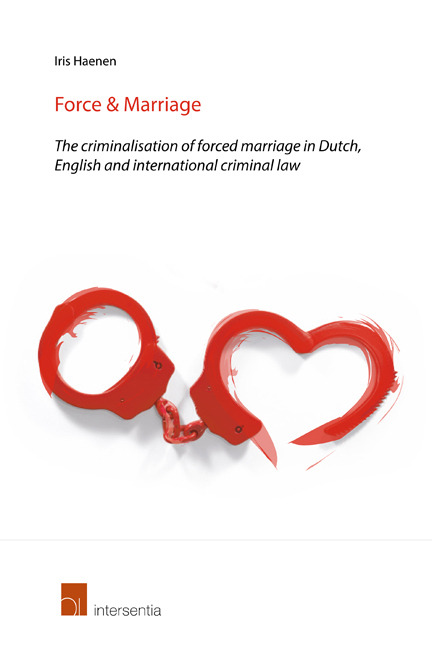 Force & Marriage
Force & Marriage Book contents
- Frontmatter
- Acknowledgements
- Contents
- Abbreviations
- General introduction
- PART I FORCE AND MARRIAGE: Description and definition of forced marriage
- PART II A TALE OF TWO THEORIES: Criminalisation on the level of national law and international law
- PART III THE LAW AND FORCED MARRIAGE: Legal frameworks concerning forced marriage in Dutch, English and international criminal law
- PART IV ANALYSIS AND CONCLUSIONS
- Chapter 10 The criminalisation of forced marriage under Dutch law and in the Rome Statute
- Summary
- Bibliography
- Table of cases
- Curriculum vitae
- Index
Chapter 10 - The criminalisation of forced marriage under Dutch law and in the Rome Statute
from PART IV - ANALYSIS AND CONCLUSIONS
Published online by Cambridge University Press: 22 November 2017
- Frontmatter
- Acknowledgements
- Contents
- Abbreviations
- General introduction
- PART I FORCE AND MARRIAGE: Description and definition of forced marriage
- PART II A TALE OF TWO THEORIES: Criminalisation on the level of national law and international law
- PART III THE LAW AND FORCED MARRIAGE: Legal frameworks concerning forced marriage in Dutch, English and international criminal law
- PART IV ANALYSIS AND CONCLUSIONS
- Chapter 10 The criminalisation of forced marriage under Dutch law and in the Rome Statute
- Summary
- Bibliography
- Table of cases
- Curriculum vitae
- Index
Summary
INTRODUCTION
(How) should forced marriage be criminalised on the levels of Dutch and international criminal law, more specifically the Rome Statute? This question formed the starting point of this research and will be answered in this chapter. The previous chapters served to pave the way by providing a definition, description and legal analysis of the phenomenon of forced marriage, by comparing the Dutch legal framework with the English framework, and by presenting frameworks that may be used as guidance in criminalisation debates. There are certain similarities between criminalisation on the two levels, yet the approaches that are taken in this chapter differ. In the first part of this chapter (paragraph 2), the criminalisation of forced marriage in the Netherlands will be addressed. The principles uncovered in Part II, especially in Chapter 4, will be used as guidelines to structure the arguments contra and pro (separate) criminalisation. The second part of this chapter (paragraph 3) goes into the criminalisation of forced marriage within the regime of the Rome Statute. The specific criminalisation requirements of crimes against humanity, war crimes and genocide will be taken into consideration. For a comparison between the two levels of criminalisation and the forced marriages that take place in times of peace and in times of conflict, see Chapter 3 (paragraph 7), Chapter 6 and Chapter 9.
THE CRIMINALISATION OF FORCED MARRIAGE AND DUTCH LAW
INTRODUCTION
Forcing someone to enter into a marriage against that person's will is a criminal act pursuant to Dutch law. As was argued in Chapter 7, this act is caught by several offences, such as the crimes of coercion, influencing someone's freedom to make an official statement and stalking. Many other European countries have also criminalised the practice and a 2011 European Council Convention requires all states parties who have not yet done so to turn forced marriage into a criminal offence.
- Type
- Chapter
- Information
- Force & MarriageThe criminalisation of forced marriage in Dutch, English and international criminal law, pp. 309 - 356Publisher: IntersentiaPrint publication year: 2014


